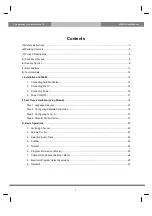
RXT-300 SmartWireless™
RXT-300 Wireless IM
Rev. 2.0
Page 23 of 41
4.2.3
RXT-300 Build Info
This section gives an overview of the data needed to configure a RXT-300. More may be needed as the
complexity increases.
RXT Name
As each RXT-300 is added the user can choose a meaningful name to represent that RXT-300. The first
several characters of this name will appear on an HMI Panel when displaying data about that RXT-300. When
adding sensors later the user will be presented with a list of RXT-300 names and will select the RXT-300
name that the sensor is attached to.
Unique Device ID
Every Detcon RXT-300 transceiver has been marked with a unique serial number on the body of the
transceiver and is used to uniquely identify it on the network. This serial number consists of 6 characters in
the form of XX.XX.XX where the X can be characters 0-9, A-F. This is really the lower portion address of the
MAC address of the radio itself. The user can use the WCT to search for wireless radios on a given RF
Channel and the serial number will appear on the screen as each one is found.
Station Application
The RXT-300 Modbus™ interface usage has to be defined – either a HMI (controller) is attached, or Sensor(s)
or none. If an HMI (controller) is attached that uses Modbus™ Exceptions, then these can be enabled. Finally
if it is used as an Alarm Station then this is enabled. The Alarm Station selection has no operational
significance. All of the RXT-300s process alarms and generate appropriate values on the Alarm Outputs. It
only allows the HMI to determine which units have Alarm devices attached to those Alarm Outputs.
NOTE:
The Modbus™ address is automatically generated by the WCT as each RXT-300 is
added. This address is then used by the HMI Panel to communicate over the Modbus™.
Battery Attached
If there is a battery installed, this will be selected in the RXT-300. The user will need to determine when a low
battery alarm will be generated if there is a battery. Time remaining alarm is set in Days / Hours / Minutes.
Alarms
There are two sets of parameters here that will be set for alarms and a third set is necessary if it is performing
the Alarm Station function. The first set is what Alarm events will be monitored for each RXT-300 which are
really the battery alarm if a battery attached and any network issues the user desires to monitor. The second
set is what Alarm Zones that the RXT-300 will be a part of. Last if it is an Alarm Station with Alarm devices
attached then how will the Alarm Output properties need to be configured. Many of these will default to
common settings but need to be reviewed by the user for their application.
4.2.4
Device (Sensor) Build Info
Devices / Sensors are added as the last step in the configuration process once the RXT-300s have been
defined. There are three main sets of parameters, the RXT-300 the sensor is associated with, the Modbus™
address / register definition and last, the range and alarm thresholds.
Device Name
As each Sensor is added the user can choose a meaningful name to represent that device. The first several
characters of this name will appear on an HMI Panel when displaying data about that device.
Device Type
This defines the type of sensor that is in use. If it is a Detcon based sensor such as a 100 Series or 700 Series
sensor most of the other parameters will be filled out since it is a known device. A device type of “Other” can
be selected and all parameters will need to be entered manually.
















































